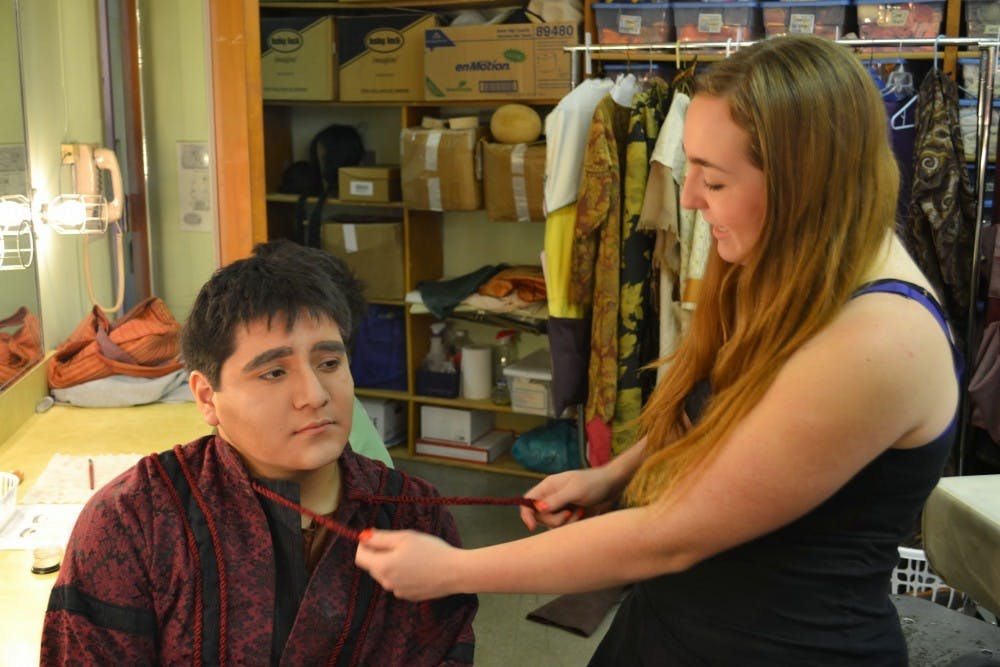[SlideDeck2 id=21045 iframe=1]
Photos by David DiLoreto
Olivia Alsept-Ellis |When the cast walks onstage to perform Shakespeare’s play “Cymbeline,” the audience will have no idea that a Pandora war has just taken place backstage.
“We’re sort of having a war with the two dressing rooms. The guys were listening to some good Backstreet Boys. So (the female dressing room) pulled up *NSYNC on our Pandora. So there was a war over who had the better dressing room,” junior Shen Telles said. “Plus we’re wearing full on rugs, it’s hard not to laugh.”
The show opened April 9 at 7:30 p.m. and will run until April 13 at 2 p.m.. And while the audience will witness the polished onstage performance, many don’t know the efforts that went on behind the scenes, from last-minute costume sewing to creative techniques of getting into character.
In order to tackle the enormous emotional weight of the play, the cast has a particular way to get into character: they personify animals.
“For our onstage personas, we were each given animals. I was given a bull. A lot of the work that goes into this is making your body look animal-like, and situating yourself like they would,” Telles said, propping up her shoulders to appear more bull-like.
Sophomore Emily Clare Biggs, who plays the Queen, is costumed in an elaborate black and red gown. She says she channels her inner black widow spider in order to understand her character.
“She’s definitely the evil, villainous mastermind,” Biggs said. “She’s all about power, and she’ll do anything to get there. She’s very driven. The costume also helps me (get into character), quite a bit -- as far as the movement of it.”
Backstage, seniors Clarke Orr, Jeffrey Phillips and junior Michael Hall were preparing their own stage makeup in the men's dressing room. Orr plays Jachimo, a performance which is part of his senior capstone. He said he gets in character by painting an intricate backstory and standing by his character’s actions.
“A wise man told me that if you know all your character’s circumstances, acting becomes inconsequential,” Orr said. “Conflict is created by my character, but I’d say there’s bigger bad guys in this play.”
“Never judge a character,” chimed in junior Noel Oishi, who plays Cornelius.
Oishi’s stage-animal is an owl, with a small metal pin on his robe to remind him.
“I’m a really visual person, so I watched a lot of videos of owls walking about to get an idea of how they hold themselves. And then I translated it into human movement,” Oishi said. “Letting the character come through the movements helps me understand how the character is as a person. How they sound and how they are going to behave.”
The casting decision is also unique. Drama professor Andrew Golla used gender-blind casting in order to utilize the large population of actresses in the theater department.
“The male roles are still male roles, and the female roles are still female roles. But a lot of male roles are played by females,” Golla said. “The story is the same. The King just happens to be played by a woman instead of a man.”
Telles’ voice boomed as she portrayed Cymbeline, King of Britain.
“Do you want the grumpy king?” Telles asked. “Thou basest thing, avoid! Hence from my sight!”
The choice of “Cymbeline” follows the last Shakespeare productions put on by UP, such as “A Midsummer Night’s Dream” and “Much Ado About Nothing.” Golla said “Cymbeline” can stand up against these more well represented Shakespeare productions because it offers an array of emotion on stage.
“There’s a whole lot of betrayal in the play, a whole lot of revenge seeking,” Golla said. “But at the end, the way everyone moves on is just by forgiving. And not forgiving people because they deserve to be forgiven but because the other choice is just to keep chasing revenge, which gets you nowhere.”








